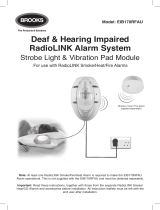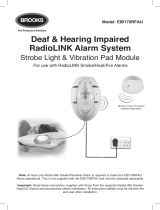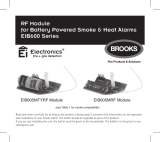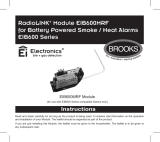4. TESTING AND MAINTAINING YOUR SYSTEM
4.1 AFTER INSTALLATION
4.1.1 Check that all RadioLINK Alarms and Accessories are powered correctly.
4.1.2 Check that the green light on the Ei170RF Strobe Module is continuously lit.
4.1.3 Press the test button on all RadioLINKED Smoke/Heat/Fire Alarms, Remote Controls and
Manual Call Points in turn, and check that all other Smoke/Heat/Fire Alarms in the system alarm after
about 4 seconds and that the strobe and vibration pad activate. Also check that the RadioLINK
accessories were operated.
N.B. Wait 12 seconds before testing the next unit or if you wish to repeat testing.
4.1.4 Press the Strobe Module test button. Check the vibration pad pulses, the strobe flashes and the
red alarm light on the Strobe Module flashes (this will also cause the Smoke/Heat/Fire Alarms to
sound and also their red lights to flash rapidly).
4.2 D
AILY & WEEKLY TESTING
Check daily that the vibration pad is in its correct position under the pillow or mattress by pressing the
test button on the Strobe Module. Also check daily that the green light on the Strobe Module is on
constantly. We recommend that you test your system weekly by pressing all the smoke/heat/fire alarm
test buttons and checking that the vibration pad and strobe light operate.
Check the Strobe Module indicator lights as follows (see figure 4)
4.2.1 Green mains power should be constantly on. If it is off check that it is plugged into the mains,
that the socket is not switched off, fuses, circuit breakers etc. If the mains is off, the green light will be
off and the unit will be running on the rechargeable battery. The green light will be replaced by an
amber flash every 4 seconds to indicate battery is satisfactory. When this amber flash stops, the
battery is depleted and the mains should be reinstated (If the mains cannot be reinstated at this time,
the depleted battery should be removed, until the mains can be re-connected).
4.2.2 Press the Test button on the Strobe Module and check that the strobe flashes, the red alarm light
flashes and that the blue RadioLINK light illuminates on for about 3 seconds indicating the radio test
signal is being sent to the Smoke/Fire/Heat alarms and any accessories.
4.2.3 Check that the amber fault light is not flashing every 4 seconds. If it is check that the primary
vibration pad is connected firmly to the socket with its plug latched (see figure 1). If the primary
vibration connection is satisfactory, it is probably indicating that the battery is depleted. Connect the
unit to the mains and check after 24 hours that the amber fault light has ceased flashing.
4.3 PERIODIC
TESTING OF RECHARGEABLE B
ATTERY
4.3.1The rechargeable battery can take up to 20 hours to charge when the unit is first powered up. It is
then maintained in a fully charged state by continuous trickle charge. In the event of a mains failure the
battery will power the system in standby for a week and then be capable of at least 4 minutes of alarm.
If the mains fails, the green light is extinguished and the amber light flashes every 4 seconds on the
Strobe Module to indicate it is on battery power. The amber light will also flash every 4 seconds if the
battery is almost depleted. Both the amber lights will go off to indicate the battery is depleted and the unit
is totally unpowered. The battery will last 5 years in normal use provided it is not exposed to extremes of
temperature for prolonged periods, or fully discharged & charged a large number of times.
We recommend that the functioning of the rechargeable battery is checked at least yearly as follows:-
4.3.2 Ensure the Strobe Module has been mains powered for at least the previous 20 hours for the
battery to charge.
4.3.3 Turn off the mains power to the unit by unplugging it or switching off the circuit at the distribution
board. Check that the green light goes off and the amber light starts to flash.
4.3.4 Press the Strobe Module test button for 20 seconds and check the strobe flashes brightly, the
pad vibrates strongly and that all the RadioLINK alarms trigger. Check that the red alarm light flashes
while the test button is pressed. (Cover the strobe light with a card to stop this dazzling you while
looking at the red light). If the red light goes off, or if the strobe is weak, or if the vibration pad is weak,
6

















